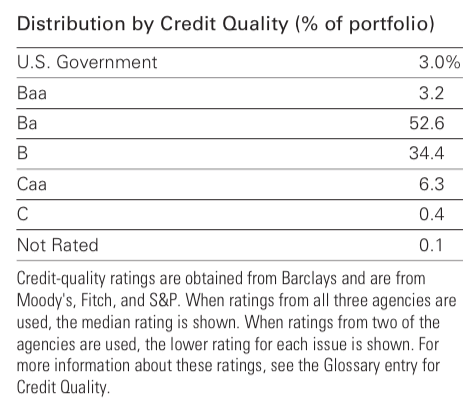 The Vanguard High-Yield Corporate Bond Fund (VWEHX, VWEAX) is a low-cost, actively-managed bond fund that invests in medium- and lower-quality corporate bonds and is advised by Wellington Management Company. I don’t own any in my retirement portfolio, but while reading the book The Affluent Investor by Phil DeMuth, I was intrigued by this interesting tidbit:
The Vanguard High-Yield Corporate Bond Fund (VWEHX, VWEAX) is a low-cost, actively-managed bond fund that invests in medium- and lower-quality corporate bonds and is advised by Wellington Management Company. I don’t own any in my retirement portfolio, but while reading the book The Affluent Investor by Phil DeMuth, I was intrigued by this interesting tidbit:
If you have settled on buying them anyway, at least wait until the spread between treasury bonds and junk bonds of the same maturity is wide (say, 4 percentage points). The fund to own is Vanguard’s (ticker: VWEHX), which has a gimmick: it buys the highest rated junk bonds. Many institutional investors can only hold investment-grade bonds as a matter of policy, and they are forced to liquidate bonds that get downgraded even when it makes no sense to do so. Vanguard lies in wait to take advantage of their mistake. This is a hedge fund strategy in a bond fund wrapper.
(I should add that this is after the author warns you about the high-yield bond asset class in general, and how if you adjust the higher yields to account for higher defaults, the net advantage can be small or even zero. He also adds that high-yield “junk” bonds are also quite volatile and should be treated like equities.)
But going back to the quote, DeMuth is saying that this fund tries to take advantage of a specific market inefficiency. I’ve never seen this strategy mentioned in either any Vanguard materials or financial media coverage. I went back and took a closer look at their prospectuses and other investor documents.
I was aware that VWEHX tends to invest in the higher-quality portion of the junk spectrum. From the Product Summary on their website:
Created in 1978, this fund seeks to purchase what the advisor considers higher-rated junk bonds. This approach aims to capture consistent income and minimize defaults and principal loss.
From the Fund Prospectus (dated 5/28/14):
The Fund invests primarily in a diversified group of high-yielding, higher-risk corporate bonds—commonly known as “junk bonds”—with medium- and lower-range credit- quality ratings. The Fund invests at least 80% of its assets in corporate bonds that are rated below Baa by Moody’s […] The Fund may not invest more than 20% of its assets in any of the following, taken as a whole: bonds with credit ratings lower than B or the equivalent, convertible securities, preferred stocks, and fixed and floating rate loans of medium- to lower-range credit quality.
Digging further into the Prospectus, we find the following under the “Security Selection” heading:
Wellington Management Company, LLP (Wellington Management), advisor to the Fund, seeks to minimize the substantial investment risk posed by junk bonds, primarily through its use of solid credit research and broad diversification among issuers. […]
The Fund will only invest in bonds and loans that, at the time of initial investment, are rated Caa or higher by Moody‘s; have an equivalent rating by any other independent bond-rating agency; or, if unrated, are determined to be of comparable quality by the advisor. […]
Wellington Management selects bonds on a company-by-company basis, emphasizing fundamental research and a long-term investment horizon. The analysis focuses on the nature of a company’s business, its strategy, and the quality of its management. Based on this analysis, the advisor looks for companies whose prospects are stable or improving and whose bonds offer an attractive yield. Companies with improving prospects are normally more attractive because they offer better assurance of debt repayment and greater potential for capital appreciation. […]
To minimize credit risk, the Fund normally diversifies its holdings among debt of at least 100 separate issuers, representing many industries. As of January 31, 2014, the Fund held debt of 172 corporate issuers. This diversification should lessen the negative impact to the Fund of a particular issuer’s failure to pay either principal or interest.
Here’s a quick summary of the Moody’s Credit Rating hierarchy, per Wikipedia:
Investment Grade
- Aaa – Highest quality and lowest credit risk.
- Aa – High quality and very low credit risk.
- A – Upper-medium grade and low credit risk.
- Baa – Medium grade, with some speculative elements and moderate credit risk.
Below-Investment Grade (“Junk”)
- Ba – Speculative elements and a significant credit risk.
- B – Speculative and a high credit risk.
- Caa -Poor quality and very high credit risk.
- Ca – Highly speculative and with likelihood of being near or in default, but some possibility of recovering principal and interest.
- C – Lowest quality, usually in default and low likelihood of recovering principal or interest.
From the Annual Report (dated 1/31/15):
This is the first time we are reporting the performance of the High-Yield Corporate Fund against its new benchmark composite index, which consists of 95% Barclays U.S. High-Yield Ba/B 2% Issuer Capped Index and 5% Barclays U.S. 1–5 Year Treasury Bond Index. As we mentioned when we made the change in November, we believe that the composite index is a better yardstick for the portfolio. It more closely reflects the portfolio’s longtime strategy of investing in higher-rated securities in the below-investment-grade category while maintaining some exposure to very liquid assets.
From Wellington Management Advisor Letter (part of Annual Report, dated 1/31/15)
The decline in commodity prices sparked a significant widening of high-yield bond spreads, and although the problems now affecting high-yield energy credits are justifiable, they are relatively isolated
to that industry. We are looking to take advantage of recent dislocations created by the sell-off in non-energy companies, where wider spreads are attractive and the credits are well-supported by strong fundamentals.
The fund remains consistent in its investment objective and strategy and maintains a significant exposure to relatively higher-rated companies in the high-yield market. We believe that these issuers have more consistent businesses and more predictable cash flows than those at the lower end of the spectrum. We prefer higher-rated credits in order to minimize defaults and provide stable income. We continue to diversify the fund’s holdings by issuer and industry and to de-emphasize non-cash-paying securities, preferred stock, and equity- linked securities (such as convertibles) because of their potential for volatility.
Costs and Fees
The expense ratio of the High-Yield Corporate Fund Investor Shares at 0.23% and Admiral Shares at 0.13% are very low in comparison to the peer group average of 1.11% for High-Yield Funds (calculated by Lipper). The fact that Vanguard itself runs at-cost and the fund advisor Wellington agrees to only takes a fee of 0.03% are quite impressive:
Wellington Management Company LLP provides investment advisory services to the fund for a fee calculated at an annual percentage rate of average net assets. For the year ended January 31, 2015, the investment advisory fee represented an effective annual rate of 0.03% of the fund’s average net assets.
In comparison, sometimes the creator of an index (like the S&P 500) will want a few basis points just for allowing a fund to follow their computer-generated list of companies. Wellington is pruning through thousands of often-illiquid bonds.
Portfolio Credit Quality
Here is the breakdown of the Vanguard High-Yield Corporate Bond Fund portfolio by credit rating as of 1/31/15. Remember that Baa and above is investment grade, so the vast majority (87%) of their holdings are indeed the top two rungs of the non-investment-grade spectrum. I assume that the 5% allocation to US government bonds is in case of an increase in fund redemptions.

Recap
I am neither recommending nor discouraging investment in this fund. There are many types of risk involved: credit risk, interest rate risk, liquidity risk, poor security selection risk. I was just intrigued by a quote in a book and wanted to dig into it further.
I have read through the prospectus and annual reports and pointed out all of what I saw were pertinent mentions of their investment and bond selection criteria. I didn’t find anything particular in Vanguard’s materials about picking bonds that have recently fallen from investment-grade to just below investment-grade, but such a strategy would certainly align with their historical portfolio and stated goals of holding the “best of the junk”.
If this is indeed a significant market inefficiency, I wonder why it still exists. Perhaps you can only do it with a very low expense ratio? I don’t believe there is any other actively-managed bond fund consisting of high-yield bonds that has such a low expense ratio; 0.13-0.23% is nearly as low as many index funds.
The low costs alone create a relative performance advantage for this fund. I chose not to emphasize past performance as that can be fleeting, but this fund’s past performance numbers also beats their Lipper peer group average over the last 1, 5, and 10 years.
Now, I do own shares of the Vanguard High-Yield Tax-Exempt Fund, which has a different advisor; Vanguard Fixed Income Group. I wonder if they do a similar thing there?
 The Best Credit Card Bonus Offers – 2025
The Best Credit Card Bonus Offers – 2025 Big List of Free Stocks from Brokerage Apps
Big List of Free Stocks from Brokerage Apps Best Interest Rates on Cash - 2025
Best Interest Rates on Cash - 2025 Free Credit Scores x 3 + Free Credit Monitoring
Free Credit Scores x 3 + Free Credit Monitoring Best No Fee 0% APR Balance Transfer Offers
Best No Fee 0% APR Balance Transfer Offers Little-Known Cellular Data Plans That Can Save Big Money
Little-Known Cellular Data Plans That Can Save Big Money How To Haggle Your Cable or Direct TV Bill
How To Haggle Your Cable or Direct TV Bill Big List of Free Consumer Data Reports (Credit, Rent, Work)
Big List of Free Consumer Data Reports (Credit, Rent, Work)
Jonathan….I’ve considered these Vanguard Funds and at the last minute have always opted for a good quality preferred from either a utility company or bank. Yields are always 5%+ on the preferreds though they are non-cumulative typically but then again if purchased below par offer almost no capital preservation risk. Its a bit of an apples and oranges comparison but how do you view the risk/advantages and disadvantages of these two asset classes.
I’ve had this fund since 2005; I couldn’t be happier. I’ve seen the share price as high as $6.30 and as low as $4.00. At the same time, the yield went as high as 13.5% while it was in the $4 range. I have not checked recently but for 7 or 8 years, according to the prospectus, it had ZERO defaults. In fact, I have yet to see a default. I’ve recently switched to the admiral shares and getting a 0.10% expense ratio. For better or worse, I’ve started to view this fund as an annuity. I doubt I will ever fully sell all my shares.
As I get closer to retirement, I look for steady forms of income. I just purchased some DVY, hopefully it will be a great position.
I like that less than 5% of the fund is in bonds with a duration of more than 10 years.
RPSIX is also a curious fund, with all kinds of bonds and a sliver of dividend stocks, but over 35% is in bonds of duration more than 10 years, and 30% in bonds with duration of more than 20 years. Better credit rating though.
A light grey font on a white background is a stunningly bad idea. VERY hard to read by anyone over age 40.
Thanks for the feedback. I will try to make the quoted text darker when I get a chance.